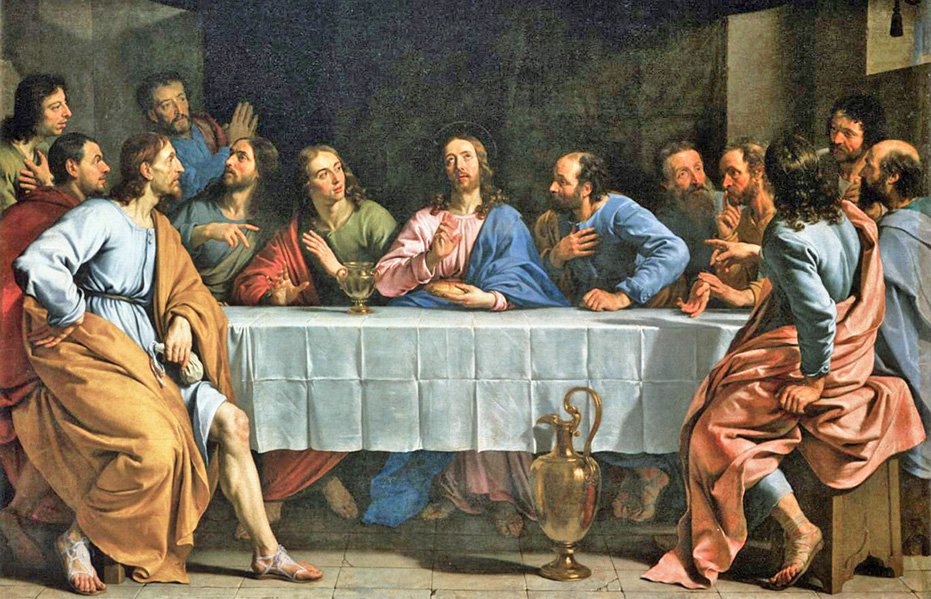 Have you ever sat and read through the gospel accounts of Passion Week, and tried to work out chronologically what is happening? And have you done that with the four gospels? (It is easiest to do that latter using a synopsis, either in print or using this one online.) If you do, you might notice several things.
Have you ever sat and read through the gospel accounts of Passion Week, and tried to work out chronologically what is happening? And have you done that with the four gospels? (It is easiest to do that latter using a synopsis, either in print or using this one online.) If you do, you might notice several things.
- Though there are variations in wording and in some details, there is a striking agreement between all four gospels in the order of the main events during the week.
- The events at the beginning of the week around Palm Sunday, and at the end of the week around the crucifixion seem very busy, yet the middle seems very quiet—the issue of the ‘silent Wednesday’.
- The main issue on which the gospel accounts disagree on the order of events is in relation to the denials of Peter by Jesus, which come earlier in Luke’s gospel, and are spread out in John’s gospel.
- Jesus’ trial is more detailed, with more people involved in different phases in John than in the Matthew and Mark, the latter two treating it in quite a compressed way as more or less a single event.
- The synoptics claim explicitly that the last supper was some form of Passover meal (which must happen after the lambs are sacrificed), whilst John makes no mention of this, and appears to have Jesus crucified at the moment that the Passover lambs are sacrificed.
These anomalies have made the question of the Passion Week chronology ‘the most intractable problem in the New Testament’, and it causes many readers to wonder whether the accounts are reliable at all. For some, they are happy to inhabit the narratives in each gospel as they are, and not worry about reconciling each account with the others, or any of the accounts with what might have actually happened. But I am not sure it is quite so easy to leave it there. After all, the word ‘gospel’ means ‘announcement of good news about something that has happened’; a central part of the Christian claim is that, in the death and resurrection of Jesus, God has done something, and so we cannot evade question of what exactly happened and when. Sceptics (both popular and academic) make much of these apparent inconsistencies, so there is an apologetic task to engage in. And understanding how these issues might be resolved could potentially shed new light on the meaning of the texts themselves.
Over Easter, I caught up with Sir Colin Humphreys’ book The Mystery of the Last Supper, in which he attempts to solve this problem. Humphreys is an academic, and a distinguished one at that, though in materials science. He has written on biblical questions before, though is not a biblical studies professional, but he does engage thoroughly with some key parts of the literature. He identifies the main elements of the puzzle under four headings:
- The lost day of Jesus, noticing the lull in activity in the middle of the week.
- The problem of the last supper; what kind of meal was it, when did it happen, and can we harmonise John’s account with the synoptics?
- No time for the trials of Jesus. If we include all the different elements, they cannot fit within the half night from Thursday to Friday morning.
- The legality of the trials. Here, Humphreys notes that later Jewish sources prohibit the conduct of a capital trial during the night, and require that any decision is ratified on the morning following the first trial.
 The book is set out very clearly and logical (as you might expect) and includes a good number of tables. Early on Humphreys helpfully tabulates the events in the gospels, showing their relationship.
The book is set out very clearly and logical (as you might expect) and includes a good number of tables. Early on Humphreys helpfully tabulates the events in the gospels, showing their relationship.
Having started by looking at the biblical texts, in the middle of the book Humphreys goes on a long scientific exploration, delving into the astronomical issues behind the construction of Jewish calendars, and using this to argue for a particular date for the crucifixion. The key issue here is identifying the dates of the calendar from what we know of the moon phases, and then finding the years when the Passover falls on a Friday, which it will do on average only one year in seven.
 Humphreys then uses other well-established data to eliminate outlying dates, and argues for Jesus’ death at 3 pm on Friday, April 3rd, AD 33. He is not alone in this, though the style of his argumentation will have lost many mainstream New Testament specialists. He assumes that the gospels are historically accurate, and takes them as his basic data, when most scholars would want him to be much more provisional. If the case was expressed more in terms of ‘were the gospels accurate, it would lead to this conclusion’ might have been more persuasive for the guild—but then Humphreys is primarily writing for a popular and not a professional audience.
Humphreys then uses other well-established data to eliminate outlying dates, and argues for Jesus’ death at 3 pm on Friday, April 3rd, AD 33. He is not alone in this, though the style of his argumentation will have lost many mainstream New Testament specialists. He assumes that the gospels are historically accurate, and takes them as his basic data, when most scholars would want him to be much more provisional. If the case was expressed more in terms of ‘were the gospels accurate, it would lead to this conclusion’ might have been more persuasive for the guild—but then Humphreys is primarily writing for a popular and not a professional audience.
I was much more interested, though, in the later chapters, where Humphreys explores the gospel texts in detail in the light of the calendrical background. Although his proposals about the different calendars in use at the time of Jesus are speculative (even if plausible), there can be no doubt that different calendars were in use, and that it is quite likely that different gospel writers are making reference to different calendar schedules which could give rise to apparent anomalies in the gospel chronologies. In particular, some calendars worked sunset to sunset (as Jewish calculation works today), others counted from sunrise to sunrise, and the Roman calendar counted from midnight to midnight, as we do now. It is not hard to see how the phrase ‘on the next day’ can now have three different possible meanings. It is also clear that the gospel writers vary in the emphasis that they give to chronological issues. So, whilst Luke offers some very specific markers in his narrative to locate the gospel story to wider world events, and John includes frequent temporal markers in relation both to Jewish feasts and successive days of Jesus’ ministry, Matthew is happy to group Jesus’ teaching and ministry into non-chronological blocks, and Mark has long been recognised as linking events in Jesus’ ministry thematically rather than chronologically. Humphreys uses an everyday example to illustrate this: if I cut the lawn and do some weeding, and someone asks my wife what I have been doing, and she says ‘He has been doing some weeding and cut the lawn’ then we would not describe our two accounts as ‘contradictory’. Chronology just hasn’t been an important issue here.
 Humphreys’ solution rests on proposing that, in celebrating the Passover with his disciples, Jesus used pre-Exile calendar which ran sunrise to sunrise and was at least a day ahead of the official Jerusalem calendar, so that there could be up to two days’ difference in calculation. This means that, if the Jerusalem Passover took place on the Friday, following the sacrifice of the lambs on Friday afternoon, it would be possible for Jesus to celebrate his own Passover (and not merely a ‘Passover-like meal’ as some scholars have suggested) as early as the Wednesday. Humphreys believes that the man carrying the water jar in Luke 22.10 and parallels is a signal that the Upper Room was in the Essene quarter of Jerusalem, where there would not have been any women to undertake such roles. And the calendar differences account for Mark’s statement that the lambs were sacrificed on the ‘first day of the feast of Unleavened Bread’, (Mark 14.12) which is a contradiction that scholars have attributed either to Mark’s error or his careless writing in the past.
Humphreys’ solution rests on proposing that, in celebrating the Passover with his disciples, Jesus used pre-Exile calendar which ran sunrise to sunrise and was at least a day ahead of the official Jerusalem calendar, so that there could be up to two days’ difference in calculation. This means that, if the Jerusalem Passover took place on the Friday, following the sacrifice of the lambs on Friday afternoon, it would be possible for Jesus to celebrate his own Passover (and not merely a ‘Passover-like meal’ as some scholars have suggested) as early as the Wednesday. Humphreys believes that the man carrying the water jar in Luke 22.10 and parallels is a signal that the Upper Room was in the Essene quarter of Jerusalem, where there would not have been any women to undertake such roles. And the calendar differences account for Mark’s statement that the lambs were sacrificed on the ‘first day of the feast of Unleavened Bread’, (Mark 14.12) which is a contradiction that scholars have attributed either to Mark’s error or his careless writing in the past.
 At some points, I think Humphrey’s case is actually slightly stronger than he claims. For example, John’s phrase ‘the Passover of the Jews’ in John 11.55 could arguably be translated as ‘the Passover of the Judeans’, thus emphasising communal and calendrical differences, and Matthew highlights the differences between the crowds of pilgrims and the local Jerusalemites in their response to Jesus. Richard Bauckham has argued that John is writing on the assumption that his readers know Mark, so there is no need for him to recount the details of the Passover meal in John 13 and following.
At some points, I think Humphrey’s case is actually slightly stronger than he claims. For example, John’s phrase ‘the Passover of the Jews’ in John 11.55 could arguably be translated as ‘the Passover of the Judeans’, thus emphasising communal and calendrical differences, and Matthew highlights the differences between the crowds of pilgrims and the local Jerusalemites in their response to Jesus. Richard Bauckham has argued that John is writing on the assumption that his readers know Mark, so there is no need for him to recount the details of the Passover meal in John 13 and following.
There are some points of strain in the argument—for me, the most testing one was Humphreys’ account of the cock crowing three times, the first of which was (he argues) the Roman horn blown to signal the approach of dawn, the gallicinium which is Latin for ‘cock crow’. But there are also some interesting ways in which his reading makes better sense of some details of the text, such as the dream of Pilate’s wife—which she could not have had time to have under the traditional chronology. Moreover, one of our earliest testimonies to the last supper, in 1 Cor 11.23, does not say (as much Anglican liturgy) ‘on the night before he died’ but ‘on the night that he was betrayed’. And when Paul says that Christ our Passover has been sacrificed for us (1 Cor 5.7), and that he is the first fruits of those who sleep (1 Cor 15.20), he is reflecting his death on Passover (as per John) and his resurrection on the celebration of First Fruits two days later.
Humphreys is certainly bold in taking on key scholars, including Dick France (with whom I would always hesitate to disagree), but in every case he gives citations and explains where the disagreement lies. When the book was first published, Mark Goodacre wrote a brief blog on why he disagrees, and the debate in comments—including from Humphreys himself—are worth reading. Mark’s main concern is Humphreys’ anxiety about demonstrating the reliability of the gospel accounts, and the need to eliminate contradictions.
One of Humphreys’s primary concerns is to avoid the idea that the Gospels “contradict themselves”. The concern is one that characterizes apologetic works and it is not a concern that I share.
But I wonder whether concern about this aim has led many scholars to dismiss the detail too quickly; much of academic scholarship is ideologically committed to the notion that the gospels are irredeemably contradictory.
I think there are some further things to explore, but it seems to me that Humphreys’ case is worth taking seriously.
Follow me on Twitter @psephizo. Like my page on Facebook.
Much of my work is done on a freelance basis. If you have valued this post, would you consider donating £1.20 a month to support the production of this blog?




























“I bless you Father, Lord of heaven and of earth, for hiding these things from the learned and clever and revealing them to little children; for thast is what it has pleased you to do” – Jesus.
Jesus also said; “Unless you become as a little child, you cannot enter the Kingdom of God.”
This is what that supreme intellectual Malcolm Muggeridge found out for himself – after his exposure to the simplicity of Mother Teresa iof Calcutta.
Professional theologians are so preoccupied with the possibilities of their next book, they often miss the point.: The gift of faith is a great mystery. It cannot be suborned by the intellect.
Christis Risen, Alleluia! He is Risen indeed, Alleluia, Alleluia!
Am I missing something with the “silent middle of the week”? Do the gospels say that the triumphal entry happened on a Sunday? It’s only a “last week” for our convenience surely! (My RSV actually allocates events to Monday, Tuesday etc, but I don’t approve.
That’s interesting. What does it list on the different days? And what happened on the Wednesday?
There is another detail that we gentiles often miss. In the week of the Passover, there was another Sabbath, a particularly holy one. This one was not on the same day each year: it was on the lunar calendar. Try this: the second Sabbath that year was Thursday. Jesus was crucified on Wednesday. The women went to the tomb on the first day of the week, after the normal Sabbath.